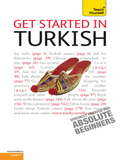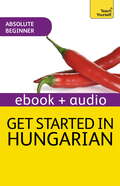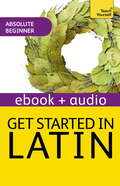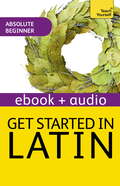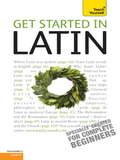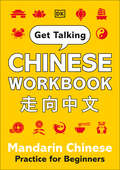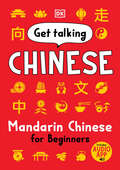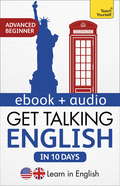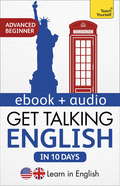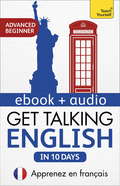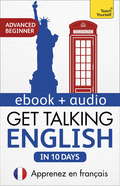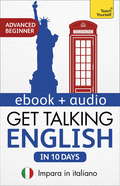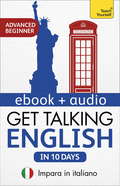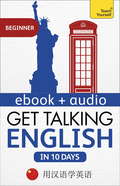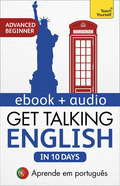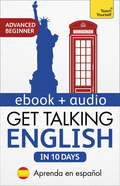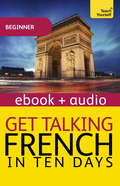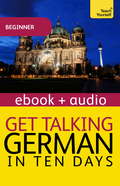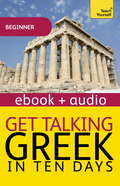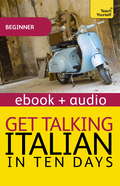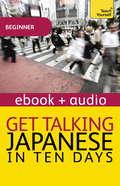- Table View
- List View
Get Started in Beginner's Spanish: Teach Yourself
by Mark Stacey Angela Gonzalez HeviaAre you looking for a course in Spanish written for the absolute beginner who has no experience of learning a foreign language? Get Started in Spanish will give you the confidence to communicate in Spanish. Now fully updated to make your language learning experience fun and interactive. You can still rely on the benefits of a top language teacher and our years of teaching experience, but now with added learning features within the course and online. The emphasis of the course is placed on communication, rather than grammar, and all the teaching is in English, so that you will quickly and effortlessly get started in Spanish. By the end of this course, you will be at Level B1 of the Common European Framework for Languages: Can deal with most situations likely to arise whilst travelling in an area where the language is spoken. Learn effortlessly with new, full-colour easy-to-read page design and interactive features: NOT GOT MUCH TIME?One, five and ten-minute introductions to key principles to get you started.AUTHOR INSIGHTSLots of instant help with common problems and quick tips for success, based on the author's many years of experience.USEFUL VOCABULARYEasy to find and learn, to build a solid foundation for speaking.DIALOGUESRead and listen to everyday dialogues to help you speak and understand fast.PRONUNCIATIONDon't sound like a tourist! Perfect your pronunciation before you go.TEST YOURSELFTests in the book and online to keep track of your progress.EXTEND YOUR KNOWLEDGEExtra online articles at: www.teachyourself.com to give you a richer understanding of the culture and history of Spain.TRY THISInnovative exercises illustrate what you've learnt and how to use it.
Get Started in Beginner's Turkish: Teach Yourself
by Asuman Çelen PollardThis product is most effective when used in conjunction with the corresponding audio support.- You can purchase the book and double CD as a pack (ISBN: 9781444105506)- The double CD is also sold separately (ISBN: 9781444105513)(copy and paste the ISBN number into the search bar to find these products)Is this the right course for you?Are you looking for a course in Turkish written for the absolute beginner who has no experience of learning a foreign language? Get Started in Turkish will give you the confidence to communicate in Turkish. Now fully updated to make your language learning experience fun and interactive. You can still rely on the benefits of a top language teacher and our years of teaching experience, but now with added learning features within the course and online. The emphasis of the course is placed on communication, rather than grammar, and all the teaching is in English, so that you will quickly and effortlessly get started in Turkish. By the end of this course, you will be at Level B1 of the Common European Framework for Languages: can deal with most situations likely to arise whilst travelling in an area where the language is spoken. Get Started in Turkish includes:Chapter 1: GreetingsChapter 2: DrinksChapter 3: AccommodationChapter 4: Eating outChapter 5: DirectionsChapter 6: I like the weather here!Chapter 7: Talking about oneself and describing peopleChapter 8: ShoppingChapter 9: Where shall we go?Chapter 10: How was it?Learn effortlessly with new, easy-to-read page design and interactive features: Not got much time?One, five and ten-minute introductions to key principles to get you started.Author insightsLots of instant help with common problems and quick tips for success, based on the author's many years of experience.Useful vocabularyEasy to find and learn, to build a solid foundation for speaking.DialoguesRead and listen to everyday dialogues to help you speak and understand fast.PronunciationDon't sound like a tourist! Perfect your pronunciation before you go.Test yourselfTests in the book and online to keep track of your progress.Extend your knowledgeExtra online articles to give you a richer understanding of the culture and history of Turkey.Try thisInnovative exercises illustrate what you've learnt and how to use it
Get Started in Hungarian Absolute Beginner Course: Enhanced Edition
by Zsuzsa PontifexIf you are an absolute beginner or simply looking for a solid foundation to your Hungarian language studies for school, work or travel, this engaging course will help get you on your way to speaking, writing, reading and understanding Hungarian in no time. Get Started in Beginner's Hungarian maps from A1 to A2 of the Common European Framework of Reference (CEFR) for Languages.Through culture notes, clear language presentations, and extensive practice and review, you will pick up the Hungarian you need to communicate naturally in everyday situations - from shopping and travelling to food and daily life.Engaging with our interactive Discovery Method, you'll absorb language rules faster, remember what you learn easily, and put your Hungarian into use with confidence.Get Started in Beginner's Hungarian has a learner-centered approach that incorporates the following features:-Outcomes-based approach - focus your learning with clear goals-Learn to learn - tips and skills on how to be a better language learner-Discovery method - figure out rules and patterns for yourself to make the language stick-Self-check and test yourself - see and assess your own progress -Personalization - use the language in real situationsRely on Teach Yourself, trusted by language learners for over 70 years.
Get Started in Latin Absolute Beginner Course: Enhanced Edition
by G D SharpleyGet Started in Latin is the ebook and audio course to follow if you are taking your first steps in Latin, whether classical or medieval. Follow a Latin story set in a medieval monastery, where conspiracy unfolds in the cloisters, Vikings threaten to attack, and young lovers set out to unmask the villains. And discover the principal authors of classical Latin and read quotations from their writings. The audio contains readings of the story and of the classical authors. All the Latin we are left with now are seemingly lifeless letters on a page or in stone. In its day Latin was a language to be heard: readings in the ancient world were recitals and performances - poems, speeches, histories even. So while you may not need the audio to learn the ABC of the language, you do if you want to experience and enjoy Latin to the full. And how do we know how it sounded? Find out inside.The free audio for this course is also available to download to the Teach Yourself Library app, or to stream on library.teachyourself.com. The ideal course to learn Latin if you're a beginner, this new edition includes:An introduction to classical Latin authors - ancient writers like Cicero, Tacitus and VirgilA medieval story : a Latin 'whodunnit' - practising each new point of languageGrammatical explanations and vocabulary support in each unitLots of exercises - to practise each new point of language Discover how Latin evolved through the centuries - and its immense impact on English Listen to the story and the classical authors on audio - to experience the sound of Latin "The best part of the book is its lively narrative...As carefully graded passages [the story sections] are much more useful than another collection I have used. The practice sections are excellent." Dr Conrad O'Briain, Trinity College Dublin "Absolutely THE best book for beginners." Amazon reviewer Rely on Teach Yourself, trusted by language learners for over 75 years.
Get Started in Latin Absolute Beginner Course: Enhanced Edition
by G D SharpleyGet Started in Latin is the ebook and audio course to follow if you are taking your first steps in Latin, whether classical or medieval. Follow a Latin story set in a medieval monastery, where conspiracy unfolds in the cloisters, Vikings threaten to attack, and young lovers set out to unmask the villains. And discover the principal authors of classical Latin and read quotations from their writings. The audio contains readings of the story and of the classical authors. All the Latin we are left with now are seemingly lifeless letters on a page or in stone. In its day Latin was a language to be heard: readings in the ancient world were recitals and performances - poems, speeches, histories even. So while you may not need the audio to learn the ABC of the language, you do if you want to experience and enjoy Latin to the full. And how do we know how it sounded? Find out inside.The free audio for this course is also available to download to the Teach Yourself Library app, or to stream on library.teachyourself.com. The ideal course to learn Latin if you're a beginner, this new edition includes: An introduction to classical Latin authors - ancient writers like Cicero, Tacitus and Virgil A medieval story : a Latin 'whodunnit' - practising each new point of language Grammatical explanations and vocabulary support in each unit Lots of exercises - to practise each new point of language Discover how Latin evolved through the centuries - and its immense impact on English Listen to the story and the classical authors on audio - to experience the sound of Latin "The best part of the book is its lively narrative...As carefully graded passages [the story sections] are much more useful than another collection I have used. The practice sections are excellent." Dr Conrad O'Briain, Trinity College Dublin "Absolutely THE best book for beginners." Amazon reviewer Rely on Teach Yourself, trusted by language learners for over 80 years.
Get Started in Latin Absolute Beginner Course: The essential introduction to reading, writing, speaking and understanding a new language
by G D SharpleyDo memories of your grammar lessons haunt you and other textbooks overwhelm you? Then Get Started in Latin is for you. Follow a Latin story set in a medieval monastery, where conspiracy unfolds in the cloisters, Vikings threaten to attack, and young lovers set out to unmask the villains. Sample some classical Latin too, and learn more about the authors who wrote it.The free audio for this course is available to download to the Teach Yourself Library app, or to stream on library.teachyourself.com. The recording contains the story and the 'Living Latin' sections of the book, and will enhance your enjoyment of the poetry and give you an idea of what Latin sounded like.Get Started in Latin is ideal for complete beginners because it introduces the language step by step through an interesting and humorous story. Each unit contains grammatical explanations and vocabulary support. There are plenty of exercises to practise each point as it is introduced and help you remember what you have learnt. There are two revision units so that you can check your progress and review areas of difficulty. 'About Latin' sections give lots of information about the history of the language and its influence upon English. 'Living Latin' sections contain pieces of authentic Latin, most of which is classical. They are included to give you an idea of what there is to enjoy once you have mastered the language and the translations are given.Learn effortlessly with new, easy-to-read page design and interactive features: NOT GOT MUCH TIME?One- and ten-minute introductions to key principles to get you started.AUTHOR INSIGHTSLots of instant help with common problems and quick tips for success, based on the author's many years of experience.USEFUL VOCABULARYEasy to find and learn, to build a solid foundation for understanding.TEST YOURSELFTests in the book and online to keep track of your progress.
Get Started in Latin Absolute Beginner Course: The essential introduction to reading, writing, speaking and understanding a new language
by G SharpleyThis product is most effective when used in conjunction with the corresponding audio support.- You can purchase the book and double CD as a pack (ISBN: 9781444101645)- The double CD is also sold separately (ISBN: 9781444101652)(copy and paste the ISBN number into the search bar to find these products)Do memories of your grammar lessons haunt you and other textbooks overwhelm you? Then Get Started in Latin is for you. Follow a Latin story set in a medieval monastery, where conspiracy unfolds in the cloisters, Vikings threaten to attack, and young lovers set out to unmask the villains. Sample some classical Latin too, and learn more about the authors who wrote it.Get Started in Latin is ideal for complete beginners because it introduces the language step by step through an interesting and humorous story. Each unit contains grammatical explanations and vocabulary support. There are plenty of exercises to practise each point as it is introduced and help you remember what you have learnt. There are two revision units so that you can check your progress and review areas of difficulty. 'About Latin' sections give lots of information about the history of the language and its influence upon English. 'Living Latin' sections contain pieces of authentic Latin, most of which is classical. They are included to give you an idea of what there is to enjoy once you have mastered the language and the translations are given.The accompanying CDs are available separately or in a pack with the book. The recording contains the story and the 'Living Latin' sections of the book, and will enhance your enjoyment of the poetry and give you an idea of what Latin sounded like.Learn effortlessly with new, easy-to-read page design and interactive features: NOT GOT MUCH TIME?One- and ten-minute introductions to key principles to get you started.AUTHOR INSIGHTSLots of instant help with common problems and quick tips for success, based on the author's many years of experience.USEFUL VOCABULARYEasy to find and learn, to build a solid foundation for understanding.TEST YOURSELFTests in the book and online to keep track of your progress.EXTEND YOUR KNOWLEDGEExtra online articles at: www.teachyourself.com to give you a richer understanding of Latin culture and Roman history.The course is available as a book (9781444101638), as a pack comprising the book and double CD (9781444101645) and as a double CD (9781444101652).
Get Talking Chinese Workbook: Mandarin Chinese Practice for Beginners
by DKA complete visual workbook for beginners learning Mandarin Chinese. A perfect companion to DK's Get Talking Chinese, sections follow a logical progression, starting with everyday words — such as "hello," "good-bye," and "thank you" — and ending with the essential vocabulary needed when shopping, ordering in a restaurant, or visiting a museum. Get Talking Chinese Workbook is more than just talk, too: An introduction to writing Chinese characters identifies the 200 most useful characters for readers to see, learn to identify, and try writing for themselves. Children, adults, and students of any age will benefit from this easy workbook, featuring plenty of knowledge-reinforcing practice and tips.
Get Talking Chinese: Mandarin Chinese for Beginners
by DKThe ultimate guide to learning basic Mandarin Chinese for kids. This easy-to-use Chinese for beginners textbook and audio app includes all the essential everyday words and phrases you need to know to start speaking Mandarin in no time!Learn how to read, write and speak Chinese step by step with this Mandarin learning book. Here&’s what&’s inside: • Content is suitable for beginners of all ages and covers basic grammar, tones, Pinyin and characters. • The accompanying audio app covers all the words and phrases taught in the book. • Bold illustrations and photos bring the text to life, and make the process of learning Mandarin fun and accessible. • Structured in short, manageable sections with practice exercises and useful tips. • Culture pages provide light relief from the language sections and cover such wide-ranging topics as etiquette, slang and the Chinese zodiac. Packed with useful tips, practice exercises and fascinating insights into Chinese culture, this Mandarin workbook for children covers Pinyin, the system used to spell out Chinese characters using Roman letters, and introduces the Chinese writing system. Bold illustrations and simple text will help you get to grips with more than 200 of the most frequently used Chinese characters. From introducing yourself in Chinese and chatting about the weather to reading and writing numbers, Easy Peasy Chinese includes all the vocabulary you&’ll need to get by in China. Plus, the accompanying audio app will help you perfect your pronunciation. It&’s perfect for children ages 8 and up, as well as beginners of all ages.
Get Talking English in Ten Days Beginner Audio Course: Learn in English: Enhanced Edition
by Rebecca MoellerLearn essential American and British English in this complete beginner audio course. This course contains:-Audio listening files -A handy phrasebook of vocabulary and phrases-Coursebook PDFs in English, French, Italian, Spanish and Portuguese for reading and writing practiceGet Talking English in Ten Days maps to A1 of the Common European Framework of Reference (CEFR) for languages.-Choose your learning language: English, French, Italian, Spanish or Portuguese-MP3 format lets you learn on the go-Practise the words and phrases you need for meeting colleagues and friends, booking a hotel, making plans, shopping and more-Progress in your understanding of naturally-paced conversations-Use the learning plus sections to extend your vocabulary-Personalize the language with interactive role-plays -Perfect your pronunciation and sound more natural*This course is also ideal for use in the classroom for extra listening and speaking practice.*Rely on Teach Yourself, trusted by language learners for over 75 years.
Get Talking English in Ten Days Beginner Audio Course: Learn in English: Enhanced Edition
by Rebecca MoellerLearn essential American and British English in this complete beginner audio course. This course contains:-One MP3 CD of audio files you can download to your computer or play in an MP3 CD player-A handy phrasebook of vocabulary and phrases-Coursebook PDFs in English, French, Italian, Spanish and Portuguese for reading and writing practiceGet Talking English in Ten Days maps to A1 of the Common European Framework of Reference (CEFR) for languages.-Choose your learning language: English, French, Italian, Spanish or Portuguese-MP3 format lets you learn on the go-Practise the words and phrases you need for meeting colleagues and friends, booking a hotel, making plans, shopping and more-Progress in your understanding of naturally-paced conversations-Use the learning plus sections to extend your vocabulary-Personalize the language with interactive role-plays -Perfect your pronunciation and sound more natural*This course is also ideal for use in the classroom for extra listening and speaking practice.*Rely on Teach Yourself, trusted by language learners for over 75 years.
Get Talking English in Ten Days Beginner Audio Course: Learn in French: Enhanced Edition
by Rebecca MoellerLearn essential American and British English in this complete beginner audio course. This course contains:-Audio listening files -A handy phrasebook of vocabulary and phrases-Coursebook PDFs in English, French, Italian, Spanish and Portuguese for reading and writing practiceGet Talking English in Ten Days maps to A1 of the Common European Framework of Reference (CEFR) for languages.-Choose your learning language: English, French, Italian, Spanish or Portuguese-MP3 format lets you learn on the go-Practise the words and phrases you need for meeting colleagues and friends, booking a hotel, making plans, shopping and more-Progress in your understanding of naturally-paced conversations-Use the learning plus sections to extend your vocabulary-Personalize the language with interactive role-plays -Perfect your pronunciation and sound more natural*This course is also ideal for use in the classroom for extra listening and speaking practice.*Rely on Teach Yourself, trusted by language learners for over 75 years.
Get Talking English in Ten Days Beginner Audio Course: Learn in French: Enhanced Edition
by Rebecca MoellerLearn essential American and British English in this complete beginner audio course. This course contains:-One MP3 CD of audio files you can download to your computer or play in an MP3 CD player-A handy phrasebook of vocabulary and phrases-Coursebook PDFs in English, French, Italian, Spanish and Portuguese for reading and writing practiceGet Talking English in Ten Days maps to A1 of the Common European Framework of Reference (CEFR) for languages.-Choose your learning language: English, French, Italian, Spanish or Portuguese-MP3 format lets you learn on the go-Practise the words and phrases you need for meeting colleagues and friends, booking a hotel, making plans, shopping and more-Progress in your understanding of naturally-paced conversations-Use the learning plus sections to extend your vocabulary-Personalize the language with interactive role-plays -Perfect your pronunciation and sound more natural*This course is also ideal for use in the classroom for extra listening and speaking practice.*Rely on Teach Yourself, trusted by language learners for over 75 years.
Get Talking English in Ten Days Beginner Audio Course: Learn in Italian: Enhanced Edition
by Rebecca MoellerLearn essential American and British English in this complete beginner audio course. This course contains:-Audio listening files -A handy phrasebook of vocabulary and phrases-Coursebook PDFs in English, French, Italian, Spanish and Portuguese for reading and writing practiceGet Talking English in Ten Days maps to A1 of the Common European Framework of Reference (CEFR) for languages.-Choose your learning language: English, French, Italian, Spanish or Portuguese-The format lets you learn on the go-Practise the words and phrases you need for meeting colleagues and friends, booking a hotel, making plans, shopping and more-Progress in your understanding of naturally-paced conversations-Use the learning plus sections to extend your vocabulary-Personalize the language with interactive role-plays -Perfect your pronunciation and sound more natural*This course is also ideal for use in the classroom for extra listening and speaking practice.*Rely on Teach Yourself, trusted by language learners for over 75 years.
Get Talking English in Ten Days Beginner Audio Course: Learn in Italian: Enhanced Edition
by Rebecca MoellerLearn essential American and British English in this complete beginner audio course. This course contains:-One MP3 CD of audio files you can download to your computer or play in an MP3 CD player-A handy phrasebook of vocabulary and phrases-Coursebook PDFs in English, French, Italian, Spanish and Portuguese for reading and writing practiceGet Talking English in Ten Days maps to A1 of the Common European Framework of Reference (CEFR) for languages.-Choose your learning language: English, French, Italian, Spanish or Portuguese-MP3 format lets you learn on the go-Practise the words and phrases you need for meeting colleagues and friends, booking a hotel, making plans, shopping and more-Progress in your understanding of naturally-paced conversations-Use the learning plus sections to extend your vocabulary-Personalize the language with interactive role-plays -Perfect your pronunciation and sound more natural*This course is also ideal for use in the classroom for extra listening and speaking practice.*Rely on Teach Yourself, trusted by language learners for over 75 years.
Get Talking English in Ten Days Beginner Audio Course: Learn in Mandarin Chinese: Enhanced Edition
by Rebecca MoellerLearn essential American and British English in this complete beginner ebook + audio course. Get Talking English in Ten Days maps to A1 of the Common European Framework of Reference (CEFR) for languages. -Practise the words and phrases you need for meeting colleagues and friends, booking a hotel, making plans, shopping and more -Progress in your understanding of naturally-paced conversations -Use the learning plus sections to extend your vocabulary -Personalise the language with interactive role-plays -Perfect your pronunciation and sound more natural *This course is also ideal for use in the classroom for extra listening and speaking practice.* Rely on Teach Yourself, trusted by language learners for over 75 years.
Get Talking English in Ten Days Beginner Audio Course: Learn in Portuguese: Enhanced Edition
by Rebecca MoellerLearn essential American and British English in this complete beginner audio course. This course contains:-Audio listening files-A handy phrasebook of vocabulary and phrases-Coursebook PDFs in English, French, Italian, Spanish and Portuguese for reading and writing practiceGet Talking English in Ten Days maps to A1 of the Common European Framework of Reference (CEFR) for languages.-Choose your learning language: English, French, Italian, Spanish or Portuguese-MP3 format lets you learn on the go-Practise the words and phrases you need for meeting colleagues and friends, booking a hotel, making plans, shopping and more-Progress in your understanding of naturally-paced conversations-Use the learning plus sections to extend your vocabulary-Personalize the language with interactive role-plays -Perfect your pronunciation and sound more natural*This course is also ideal for use in the classroom for extra listening and speaking practice.*Rely on Teach Yourself, trusted by language learners for over 75 years.
Get Talking English in Ten Days Beginner Audio Course: Learn in Spanish: Enhanced Edition
by Rebecca MoellerLearn essential American and British English in this complete beginner audio course. This course contains:-Audio listening files -A handy phrasebook of vocabulary and phrases-Coursebook PDFs in English, French, Italian, Spanish and Portuguese for reading and writing practiceGet Talking English in Ten Days maps to A1 of the Common European Framework of Reference (CEFR) for languages.-Choose your learning language: English, French, Italian, Spanish or Portuguese-MP3 format lets you learn on the go-Practise the words and phrases you need for meeting colleagues and friends, booking a hotel, making plans, shopping and more-Progress in your understanding of naturally-paced conversations-Use the learning plus sections to extend your vocabulary-Personalize the language with interactive role-plays -Perfect your pronunciation and sound more natural*This course is also ideal for use in the classroom for extra listening and speaking practice.*Rely on Teach Yourself, trusted by language learners for over 75 years.
Get Talking English in Ten Days Beginner Audio Course: Learn in Spanish: Enhanced Edition
by Rebecca MoellerLearn essential American and British English in this complete beginner audio course. This course contains:-One MP3 CD of audio files you can download to your computer or play in an MP3 CD player-A handy phrasebook of vocabulary and phrases-Coursebook PDFs in English, French, Italian, Spanish and Portuguese for reading and writing practiceGet Talking English in Ten Days maps to A1 of the Common European Framework of Reference (CEFR) for languages.-Choose your learning language: English, French, Italian, Spanish or Portuguese-MP3 format lets you learn on the go-Practise the words and phrases you need for meeting colleagues and friends, booking a hotel, making plans, shopping and more-Progress in your understanding of naturally-paced conversations-Use the learning plus sections to extend your vocabulary-Personalize the language with interactive role-plays -Perfect your pronunciation and sound more natural*This course is also ideal for use in the classroom for extra listening and speaking practice.*Rely on Teach Yourself, trusted by language learners for over 75 years.
Get Talking French in Ten Days Beginner Audio Course: Enhanced Edition
by Jean-Claude ArragonWhen travelling, do you want to journey off the English-speaking path, meet people and speak French easily?If so then you need to Get Talking. Through 10 common scenarios plus culture and travel advice, you'll learn the skills for understanding and the confidence to speak French in just 10 days.Practise the most frequent words and expressions for:-introducing yourself-booking a room-checking into a hotel-asking for directions-getting in touch with an old friend-meeting an old friend for coffee-booking a table at a restaurant-arriving at a restaurant for dinner-ordering a meal-going to the chemist's.You'll progress in your understanding of naturally-paced conversations, be able to personalize the language through interactive role-plays and perfect your pronunciation to sound more natural.This absolute beginner French course contains an MP3 CD. You can download the audio files on this disc from your computer to your MP3 player or play it in an MP3 CD player. Also included is a handy phrasebook and a PDF coursebook for reading and writing practice.Get Talking French in Ten Days maps to A1 of the Common European Framework of Reference (CEFR) for languages.Rely on Teach Yourself, trusted by language learners for over 75 years.
Get Talking German in Ten Days Beginner Audio Course: Enhanced Edition
by Paul Coggle Heiner SchenkeWhen travelling, do you want to journey off the English-speaking path, meet people and communicate easily?If so then you need to Get Talking. Through 10 common scenarios plus culture and travel advice, you'll learn the skills for understanding and the confidence to speak German in just 10 days.Practise the most frequent words and expressions for:-Getting a taxi-Checking into a hotel-Introducing yourself at a reception-Ordering drinks-Ordering a snack-Asking the way to the tourist information office-Taking the bus-Finding out about tickets-At the pharmacy-Buying clothes.You'll progress in your understanding of naturally-paced conversations, be able to personalise the language through interactive role-plays and perfect your pronunciation to sound more natural.Rely on Teach Yourself, trusted by language learners for over 70 years.
Get Talking Greek: Enhanced Edition
by Howard Middle Hara Garoufalia-MiddleWhen travelling, do you want to journey off the English-speaking path, meet people and communicate easily? If so then you need to Get Talking. Through 10 common scenarios plus culture and travel advice, you'll learn the skills for understanding and the confidence to speak Greek in just 10 days.Practise the most frequent words and expressions for:-Making introductions and greeting-Making more introductions-Talking about your family-Saying where you live-Asking about directions and public transport-Finding your way around-Making a hotel reservation-Booking a hotel for friends-Eating out-Ordering food and drink.You'll progress in your understanding of naturally-paced conversations, be able to personalise the language through interactive role-plays and perfect your pronunciation to sound more natural.Rely on Teach Yourself, trusted by language learners for over 70 years
Get Talking Italian in Ten Days Beginner Audio Course: Enhanced Edition
by Federica Sturani Maria GuarnieriWhen travelling, do you want to journey off the English-speaking path, meet people and speak Italian easily? If so then you need to Get Talking. Through 10 common scenarios plus culture and travel advice, you'll learn the skills for understanding and the confidence to speak Italian in just 10 days. Practise the most frequent words and expressions for: -getting a taxi -hiring a car -getting a bus -booking a room -having a coffee -having a meal -going shopping -going to the local museum -going to the opera -going to the chemist's. You'll progress in your understanding of naturally-paced conversations, be able to personalize the language through interactive role-plays and perfect your pronunciation to sound more natural. This absolute beginner Italian course contains an MP3 CD. You can download the audio files on this disc from your computer to your MP3 player or play it in an MP3 CD player. Also included is a handy phrasebook and a PDF coursebook for reading and writing practice. Get Talking Italian in Ten Days maps to A1 of the Common European Framework of Reference (CEFR) for languages. Rely on Teach Yourself, trusted by language learners for over 75 years.
Get Talking Japanese in Ten Days Beginner Audio Course: Enhanced Edition
by Helen GilhoolyWhen travelling, do you want to journey off the English-speaking path, meet people and communicate easily? If so then you need to Get Talking. Through 10 common scenarios plus culture and travel advice, you'll learn the skills for understanding and the confidence to speak Japanese in just 10 days. Practise the most frequent words and expressions for: -making introductions and greetings -making phone calls -eating out -buying souvenirs -buying food and drink -asking for directions -Sightseeing -talking about illness -talking on the move -visiting a Japanese home. You'll progress in your understanding of naturally-paced conversations, be able to personalise the language through interactive role-plays and perfect your pronunciation to sound more natural. Rely on Teach Yourself, trusted by language learners for over 70 years.
Get Talking Korean in Ten Days Beginner Audio Course: Enhanced Edition
by Robert Vernon Kyung-Il KwakWhen travelling, do you want to journey off the English-speaking path, meet people and speak Korean easily?If so then you need to Get Talking. Through 10 common scenarios plus culture and travel advice, you'll learn the skills for understanding and the confidence to speak Korean in just 10 days. Practise the most frequent words and expressions for: -greeting people -eating out -taking a taxi -asking for directions -going to see a movie -shopping for food -going to a department store -going to a bar -feeling ill -taking a trip including booking into a hotel.You'll progress in your understanding of naturally-paced conversations, be able to personalize the language through interactive role-plays and perfect your pronunciation to sound more natural.Get Talking Korean in Ten Days maps to A1 of the Common European Framework of Reference (CEFR) for languages.Rely on Teach Yourself, trusted by language learners for over 75 years.

